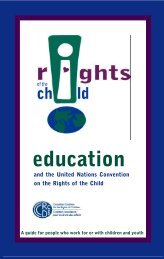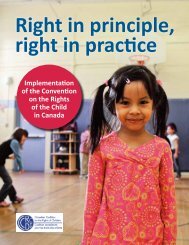Poste - Canadian Coalition for the Rights of Children
Poste - Canadian Coalition for the Rights of Children
Poste - Canadian Coalition for the Rights of Children
Create successful ePaper yourself
Turn your PDF publications into a flip-book with our unique Google optimized e-Paper software.
The <strong>Canadian</strong> Association <strong>of</strong> <strong>the</strong> Deaf argues that<br />
specialized learning is <strong>of</strong>ten necessary <strong>for</strong> children who<br />
are deaf because “<strong>the</strong> regular school is <strong>the</strong> least enabling<br />
environment” <strong>for</strong> many students due to “very weak”<br />
support services. Academic per<strong>for</strong>mance, language skills<br />
acquisition and social, psychological and cultural factors,<br />
including a lack <strong>of</strong> peers, all justify centralized deaf<br />
schools as “a valuable option particularly <strong>for</strong> prelingually<br />
or early-deafened children.” 137<br />
Every province and territory except Northwest Territories<br />
provides segregated education programs <strong>for</strong> students with<br />
ongoing behavioural problems or those who are blind or<br />
deaf. There are no special or segregated education<br />
programs <strong>for</strong> Aboriginal students on reserves. 138<br />
Recent changes to specialized learning include <strong>the</strong><br />
following:<br />
• The 1999 federal budget expanded tax relief <strong>for</strong><br />
parents <strong>of</strong> children with disabilities to include learning<br />
disabilities. 139<br />
• Alberta is adding 590 full-time intern teachers <strong>for</strong><br />
literacy assessment and assistance in kindergarten and<br />
Grades 1 and 2.<br />
• Saskatchewan has devoted $3.3 million in 1998/<br />
1999 to <strong>the</strong> Education <strong>for</strong> Vulnerable <strong>Children</strong><br />
program, which assists school divisions in providing<br />
<strong>for</strong> children with special needs. A “substantial portion”<br />
<strong>of</strong> this funding targets students with social,<br />
behavioural and emotional difficulties.<br />
• Despite widespread budget cuts to public services,<br />
Ontario has maintained its special education budget at<br />
$1.2 billion, most <strong>of</strong> which is devoted to programming<br />
<strong>for</strong> <strong>the</strong> learning disabled. 140 However, no framework<br />
ensures that this $1.2 billion is in fact spent on this<br />
group <strong>of</strong> children.<br />
• There is no in<strong>for</strong>mation available about<br />
accountability frameworks in o<strong>the</strong>r jurisdictions. 141<br />
Services <strong>for</strong> blind or deaf students vary across <strong>the</strong><br />
country.<br />
• In 1995-96, 2,461 students attended schools <strong>for</strong> <strong>the</strong><br />
deaf and blind in Canada. There is one separate school<br />
<strong>for</strong> <strong>the</strong> deaf and <strong>the</strong> blind in Nova Scotia.<br />
• Schools <strong>for</strong> <strong>the</strong> deaf exist in Alberta, British<br />
Columbia, Manitoba, Ontario and Quebec and <strong>the</strong>y<br />
have been closed in New Brunswick, Newfoundland,<br />
Saskatchewan and Prince Edward Island.<br />
• All provinces and <strong>the</strong> Yukon have local programming<br />
<strong>for</strong> blind students.<br />
H O W D O E S C A N A D A M E A S U R E U P ?<br />
67<br />
• There is one school <strong>for</strong> <strong>the</strong> blind in Ontario.<br />
• Most major <strong>Canadian</strong> cities have <strong>Canadian</strong> National<br />
Institute <strong>for</strong> <strong>the</strong> Blind centres, which <strong>of</strong>fer white cane<br />
training, instruction in visual aids, printed material on<br />
tape and braille resources. 142<br />
Limited funds <strong>for</strong> public education result in competition<br />
between different groups <strong>of</strong> students with special needs <strong>for</strong><br />
various learning programs. 143 Yude Henteleff, honorary<br />
counsel <strong>for</strong> <strong>the</strong> Learning Disabilities Association <strong>of</strong><br />
Canada, says that certain school districts will not <strong>of</strong>fer<br />
special help to a poor learner unless that child falls two<br />
years behind; o<strong>the</strong>rs cut extra tutorials or special classes<br />
once a child shows some progress. 144 There is uneven<br />
availability in services within a city and between provinces<br />
due to different rules, regulations and budgets available to<br />
children.<br />
Parents have fought legal battles to get education services<br />
<strong>for</strong> children with disabilities. 145 For example, in August<br />
1998, six families in Prince Albert, Saskatchewan won <strong>the</strong><br />
right to challenge <strong>the</strong> province and <strong>the</strong> boards <strong>of</strong> education<br />
over schooling provided to <strong>the</strong>ir children with learning<br />
disabilities. 146 The issue is currently be<strong>for</strong>e <strong>the</strong> court.<br />
Preparation <strong>for</strong> Employment and<br />
Rehabilitation<br />
Rehabilitation services provide opportunities to develop<br />
basic skills and can be important to prepare people to take<br />
on school and work. However, <strong>the</strong>se services and relevant<br />
supports are only partially covered by government. People<br />
have limited access in Canada to services such as<br />
physio<strong>the</strong>rapy, occupational <strong>the</strong>rapy or speech <strong>the</strong>rapy. 147<br />
Only 48 percent <strong>of</strong> working-age <strong>Canadian</strong>s with<br />
disabilities are in <strong>the</strong> paid labour <strong>for</strong>ce, compared with 73<br />
percent <strong>of</strong> persons without disabilities. Only 31 percent <strong>of</strong><br />
people with intellectual disabilities have jobs. 148 In October<br />
1997, federal, provincial, territorial ministers (except<br />
Quebec) approved a new multilateral framework <strong>for</strong><br />
Employability Assistance <strong>for</strong> Persons with Disabilities.<br />
This program includes funding <strong>for</strong> students with<br />
disabilities. 149<br />
Governments fund various pre-vocational and vocational<br />
training opportunities <strong>for</strong> youth with disabilities. The more<br />
education and training people get, <strong>the</strong> more likely <strong>the</strong>y are<br />
to pursue and obtain employment but <strong>for</strong> persons with<br />
disabilities, opportunities can be limited. 150 In November<br />
1998, Human Resources Development Canada announced




